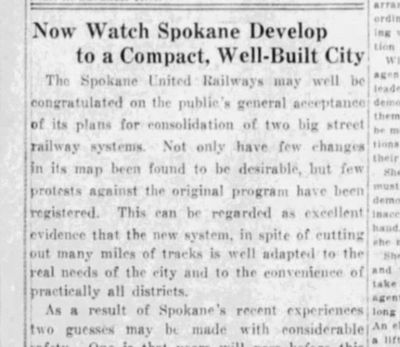This column reflects the opinion of the writer. Learn about the differences between a news story and an opinion column.
100 years ago in Spokane: The city’s new streetcar merger was seen as revolutionary, but major change in the world of transportation would turn out to be looming

The merger of Spokane’s two streetcar systems had been in effect for a week, and the Spokane Daily Chronicle declared it a historic success.
The merger had gone smoothly, with “few protests” registered.
“As a result of Spokane’s recent experiences, two guesses may be made with considerable safety,” the Chronicle’s editors wrote. “One, is that years will pass before this city repeats the experiment of operating two street railway systems; the other is that the company now taking control will be hard to tempt into building speculative extensions of its tracks. The ‘new addition to Spokane’ is likely to be a rare article for some time to come; and the next ten years will do much to change Spokane into a compact city with a longer list of fine residence streets and shorter mileage of vacant lot frontage. There is plenty of land within close reach of the consolidated care line to accommodate homes for 250,000 people without a bit of crowding.”
What the editors failed to predict was that the entire streetcar era would come to an end in the 1930s, replaced by buses. Before long, auto commuting would reign supreme, enabling development farther out into the suburbs.
From the parks beat: Superintendent of Parks John Duncan had a dilemma: How to capture 500 goldfish in the Manito Park pond?
The last time this was done, Duncan had to drain the pond and employ three men to corral the fish.
This time, Duncan convinced the parks board to agree to an ingenious solution. The Davenport Hotel offered to catch the fish at its own expense, and the hotel could keep the fish for “decorative purposes,” presumably in its fountains.